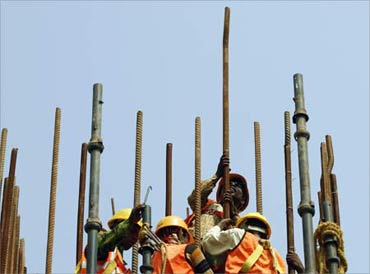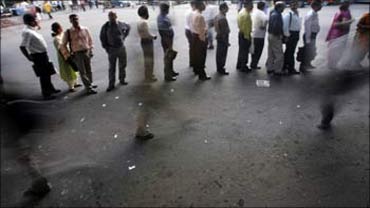 | « Back to article | Print this article |
Where have all the jobs gone?
Although India's GDP growth has recovered fast from the global crisis, very little is reliably known on whether it has generated adequate employment opportunities or has remained jobless in nature.
In advanced economies, a revival in output is occurring but with double-digit rates of unemployment. According to the Economist, India is not too far behind with a joblessness rate of 10.7 per cent in 2009.
But this is clearly only a guesstimate as the latest official number on the rate of unemployment is eight per cent on a daily status basis in 2007-08.
Unlike advanced countries where up-to-date information is available on labour market behaviour, this information is available in India only with a five-year lag. The last comprehensive survey of the National Sample Survey Organisation (NSSO) pertains to 2004-05.
The next survey for 2009-10 has just been completed and the results will be published in 2011. The ministry of labour and employment, however, has so far conducted six successive quarterly surveys on the effect of the global slowdown between October-December 2008 and January-March 2010.
Click NEXT to read on . . .
Where have all the jobs gone?
These surveys indicate that there has been a net addition of 850,000 jobs in a sample of firms in industries like textiles including apparels, leather, metals, automobiles, gems and jewellery, transport and IT/BPO.
The earlier quarters -- October-December 2008 and April-June 2009 show a net decline in employment but there has been a turnaround since then.
However, the fact that two-thirds of such employment has been generated only in IT/BPO sector while it is shrinking in labour-intensive sectors like textiles hardly indicates any broad-based upswing in overall job creation.
Given the unavailability of NSSO's latest 2009-10 data, the Annual Report to the People on Employment from the ministry of labour perforce has had to make projections from the 2004-05 survey for making estimates of the labour force for 2009-10 and thereafter.
Click NEXT to read on . . .
Where have all the jobs gone?
However, researchers are unlikely to be enthused by the report's findings as the unemployment rate derived from that estimate for 2009-10 is only a lowly 2.7 per cent on a usual status basis as it includes persons who are out of work and are seeking or available for work over a year.
Longer-term unemployment rates are unlikely to capture the impact of the global crisis on GDP growth in India and the resultant spike upwards in joblessness. They remain low because in a country with pervasive poverty few can afford to remain unemployed for long stretches of time.
They are forced to take up self-employment or casual odd jobbing in the unorganised sector than be without work. Unemployment rates on a daily status basis that capture those seeking/available for work on a typical day in the year are certainly a better indicator than the usual status one.
Like the ministry of labour's report, one can extrapolate from earlier NSSO five-year surveys to derive more recent estimates, especially after the global crisis hit India.
Click NEXT to read on . . .
Where have all the jobs gone?
A disturbing fact is the sharp deceleration in employment growth to 1.8 per cent per annum from 1993-94 to 2006-07 from 2.6 per cent between 1983-1993-94 although growth accelerated to 6.3 per cent from five per cent over this period.
These numbers imply a decline in employment per unit of GDP growth or employment elasticity to 0.28 from 1993-94 to 2006-07 from 0.52 over the years 1983-1993-94.
Applying this elasticity to the likely GDP growth of 7.4 per cent in 2009-10 to project the generation of employment provides an average of 8.7 million jobs generated last year. This is significantly short of the annual average 10 million opportunities generated before the global crisis struck.
In other words, around 1.3 million fewer jobs were generated last fiscal despite a recovery in GDP growth. This shrinkage of employment opportunities when nine to 10 million people look for work every year will only swell the reserve army of the unemployed.
Click NEXT to read on . . .
Where have all the jobs gone?
The number of unemployed in 2009-10 is substantial at 36.2 million out of a labour force of 465.3 million on a daily status basis, if one uses the projections of the Planning Commission for the Eleventh Plan (2007-2012).
Disturbingly, the rate of unemployment appears stuck at around eight per cent. This rate did not budge from this level even when the economy experienced faster growth of 9.5 per cent in 2005-06 and 9.2 per cent in 2007-08. This was the case even when the global crisis impacted the economy and GDP growth plunged to 6.7 per cent in 2008-09.
Whether unemployment rates have become entrenched, impervious to the revival in GDP growth, however, is a task for deeper study. Certainly, the availability of NSSO's comprehensive survey data for 2009-10 will shed light on this matter.
The fact that fewer employment opportunities are being generated when nine to 10 million people join the labour force each year obviously implies that the rapid recovery of the economy from the global crisis is basically jobless in nature -- notwithstanding the good news regarding hirings in the IT/BPO space.





